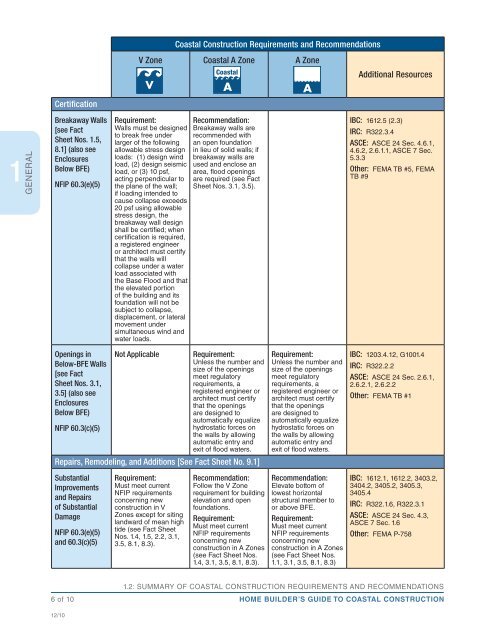FEMA P-499: Home Builder's Guide to Coastal Construction
FEMA P-499: Home Builder's Guide to Coastal Construction
FEMA P-499: Home Builder's Guide to Coastal Construction
You also want an ePaper? Increase the reach of your titles
YUMPU automatically turns print PDFs into web optimized ePapers that Google loves.
1<br />
GENERAL<br />
Certification<br />
Breakaway Walls<br />
[see Fact<br />
Sheet Nos. 1.5,<br />
8.1] (also see<br />
Enclosures<br />
Below BFE)<br />
NFIP 60.3(e)(5)<br />
Openings in<br />
Below-BFE Walls<br />
[see Fact<br />
Sheet Nos. 3.1,<br />
3.5] (also see<br />
Enclosures<br />
Below BFE)<br />
NFIP 60.3(c)(5)<br />
<strong>Coastal</strong> <strong>Construction</strong> Requirements and Recommendations<br />
V Zone <strong>Coastal</strong> A Zone A Zone<br />
Requirement:<br />
Walls must be designed<br />
<strong>to</strong> break free under<br />
larger of the following<br />
allowable stress design<br />
loads: (1) design wind<br />
load, (2) design seismic<br />
load, or (3) 10 psf,<br />
acting perpendicular <strong>to</strong><br />
the plane of the wall;<br />
if loading intended <strong>to</strong><br />
cause collapse exceeds<br />
20 psf using allowable<br />
stress design, the<br />
breakaway wall design<br />
shall be certified; when<br />
certification is required,<br />
a registered engineer<br />
or architect must certify<br />
that the walls will<br />
collapse under a water<br />
load associated with<br />
the Base Flood and that<br />
the elevated portion<br />
of the building and its<br />
foundation will not be<br />
subject <strong>to</strong> collapse,<br />
displacement, or lateral<br />
movement under<br />
simultaneous wind and<br />
water loads.<br />
Recommendation:<br />
Breakaway walls are<br />
recommended with<br />
an open foundation<br />
in lieu of solid walls; if<br />
breakaway walls are<br />
used and enclose an<br />
area, flood openings<br />
are required (see Fact<br />
Sheet Nos. 3.1, 3.5).<br />
Not Applicable Requirement:<br />
Unless the number and<br />
size of the openings<br />
meet regula<strong>to</strong>ry<br />
requirements, a<br />
registered engineer or<br />
architect must certify<br />
that the openings<br />
are designed <strong>to</strong><br />
au<strong>to</strong>matically equalize<br />
hydrostatic forces on<br />
the walls by allowing<br />
au<strong>to</strong>matic entry and<br />
exit of flood waters.<br />
Repairs, Remodeling, and Additions [See Fact Sheet No. 9.1]<br />
Substantial<br />
Improvements<br />
and Repairs<br />
of Substantial<br />
Damage<br />
NFIP 60.3(e)(5)<br />
and 60.3(c)(5)<br />
6 of 10<br />
12/10<br />
Requirement:<br />
Must meet current<br />
NFIP requirements<br />
concerning new<br />
construction in V<br />
Zones except for siting<br />
landward of mean high<br />
tide (see Fact Sheet<br />
Nos. 1.4, 1.5, 2.2, 3.1,<br />
3.5, 8.1, 8.3).<br />
Recommendation:<br />
Follow the V Zone<br />
requirement for building<br />
elevation and open<br />
foundations.<br />
Requirement:<br />
Must meet current<br />
NFIP requirements<br />
concerning new<br />
construction in A Zones<br />
(see Fact Sheet Nos.<br />
1.4, 3.1, 3.5, 8.1, 8.3).<br />
Requirement:<br />
Unless the number and<br />
size of the openings<br />
meet regula<strong>to</strong>ry<br />
requirements, a<br />
registered engineer or<br />
architect must certify<br />
that the openings<br />
are designed <strong>to</strong><br />
au<strong>to</strong>matically equalize<br />
hydrostatic forces on<br />
the walls by allowing<br />
au<strong>to</strong>matic entry and<br />
exit of flood waters.<br />
Recommendation:<br />
Elevate bot<strong>to</strong>m of<br />
lowest horizontal<br />
structural member <strong>to</strong><br />
or above BFE.<br />
Requirement:<br />
Must meet current<br />
NFIP requirements<br />
concerning new<br />
construction in A Zones<br />
(see Fact Sheet Nos.<br />
1.1, 3.1, 3.5, 8.1, 8.3)<br />
Additional Resources<br />
IBC: 1612.5 (2.3)<br />
IRC: R322.3.4<br />
ASCE: ASCE 24 Sec. 4.6.1,<br />
4.6.2, 2.6.1.1, ASCE 7 Sec.<br />
5.3.3<br />
Other: <strong>FEMA</strong> TB #5, <strong>FEMA</strong><br />
TB #9<br />
IBC: 1203.4.12, G1001.4<br />
IRC: R322.2.2<br />
ASCE: ASCE 24 Sec. 2.6.1,<br />
2.6.2.1, 2.6.2.2<br />
Other: <strong>FEMA</strong> TB #1<br />
IBC: 1612.1, 1612.2, 3403.2,<br />
3404.2, 3405.2, 3405.3,<br />
3405.4<br />
IRC: R322.1.6, R322.3.1<br />
ASCE: ASCE 24 Sec. 4.3,<br />
ASCE 7 Sec. 1.6<br />
Other: <strong>FEMA</strong> P-758<br />
1.2: SUMMARY OF COASTAL CONSTRUCTION REQUIREMENTS AND RECOMMENDATIONS<br />
HOME BUILDER’S GUIDE TO COASTAL CONSTRUCTION


